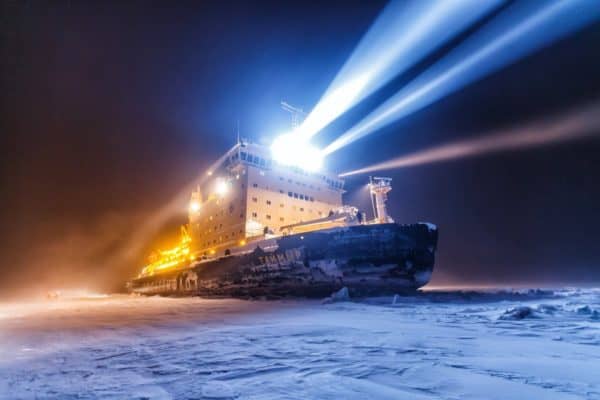
The main transport artery of Russia. Domestic and foreign researchers have been trying to overcome the harsh conditions of the Arctic for centuries. Today, the Northern Sea Route is the shortest distance between the European part of Russia and the Far East.
The route passes through the seas of the Arctic Ocean. For the first time in one navigation of the NSR, Otto Schmidt’s expedition took place in 1932 on the icebreaking steamer «Alexander Sibiryakov». The crew struggled with the ice, changed the propeller blades, and drifted. The goal was worth it: on October 1, the team reached Bering Bay. This was an incredible event for the Soviet period: the first steps along the Northern Sea Route were a feat, and the researchers who returned from the expedition were admired.
The Northern Sea Route from the Kara Gate to Providence Bay is 5 600 km. For comparison: the Suez Canal is several times longer. Thus, the distance that ships travel from Murmansk to the Japanese port of Yokohama via the Suez Canal will be 12 840 nautical miles. The exact route along the NSR has a length of 5 777 nautical miles. Also, according to the NSR, the cargo transportation time is reduced by 40% (instead of 22 days, the goods are delivered in 14-15 days). Due to this, sea transport consumes less fuel, which undoubtedly makes the route attractive from an economic point of view.
One of the main advantages of the NSR, in addition to its length, was security. Unlike the waters of the Indian Ocean, there are practically no storms in the sea expanses of the NSR, and there is no piracy. This eliminates the need for cargo insurance due to pirates.
Another advantage of the NSR is the absence of queues and passage fees, unlike the already mentioned Suez Canal, where there are restrictions on the size of ships and tonnage.
And finally, the third advantage of the Northern Sea Route is its contribution to the preservation of the ecology of our planet. According to the estimates of the International Maritime Organization, maritime transport leaves about 2.9% of carbon dioxide emissions from the global amount. By 2050, the organization has committed its carriers to reduce CO2 emissions by 50%. However, whether it will be possible to achieve this indicator is a question. At the moment, there is no reliable technology that would replace marine engines. And they are known to run on fuel. Due to the length of the NSR route, sea transport spends less energy and reduces the amount of carbon footprint. Thus, playing a significant role in achieving the goal of the Paris Climate Agreement.
The Northern Sea Route is of particular importance to the Russian economy. This unique transport artery for some northern regions of our country has become the only way to deliver goods. The NSR also helps to connect remote territories: it provides residents of the areas with necessary goods, stimulates the development of these same regions, and improves the quality of life of people.
Rosatom State Nuclear Corporation strives to make the Northern Sea Route an effective transport artery. The company is a Legacy member of the Arctic Economic Council. This is an essential platform for the development of economic cooperation.
In the waters of the Northern Sea Route, Rosatom organizes the navigation of ships per the Code of Merchant Shipping, manages a fleet of nuclear icebreakers, and is also engaged in navigation and hydrographic support of navigation. In addition, the Directorate of the Northern Sea Route was created to develop the infrastructure of seaports in the waters of the NSR and manage state property in these zones. She works with several organizations: «Atomflot», «Hydrographic Enterprise», and «Chukotatomenergo».
In turn, based on the Naval Operations Headquarters of FSUE «Atomflot», the FSBI «Main Directorate of the Northern Sea Route» («Glavsevmorput») was established. The division provides the organization of icebreaking vessels in the waters of the NSR, develops navigation routes for ships, and deals with the arrangement of icebreaking fleet vessels taking into account the hydrometeorological, ice, and navigation conditions.
Today Russia has the only icebreaker fleet in the world: «Yamal», «50 Years of Victory», «Taimyr», «Vaigach», «Arctic», and «Siberia». Meanwhile, three more nuclear icebreakers are constructed in St. Petersburg: «Ural», «Yakutia», and «Chukotka». It is noted that they will be universal and will be able to change the draft depending on the depth. The construction of the most powerful icebreaker in the world, the «Rossiya», with a capacity of 120 MW, is also underway, scheduled for commissioning in 2027.
In 2021, experts noted a record growth in cargo transportation along the Northern Sea Route. Volumes amounted to 43.85 million tons. For comparison: in 1987, the figure was only 6.5 million tons. Interestingly, the NSR has become in demand among foreign carriers. So, last year 75 foreign vessels passed along the route. In 2020 — 42 “foreigners”. According to statistics, transit cargo traffic exceeded 2 million tons, 59% higher than in 2020.
 Gearfuse Technology, Science, Culture & More
Gearfuse Technology, Science, Culture & More


